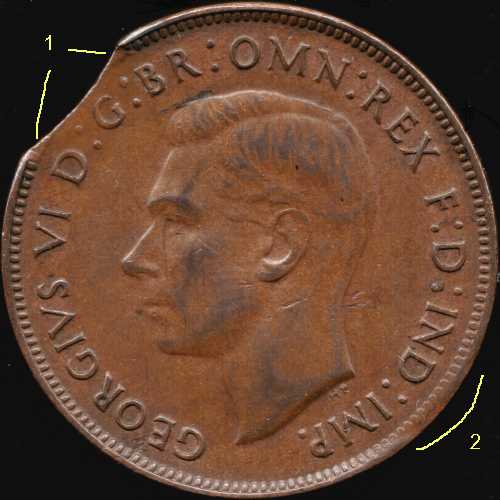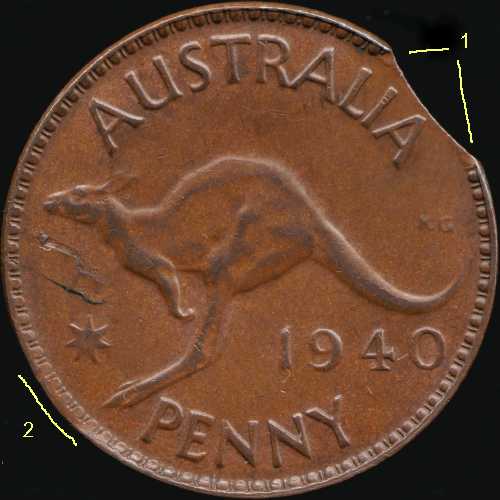 |
 |
2. Blakesley effect (named for the American numismatist who first described it)
occurs diametrically opposite the missing segment. See description below.
|
|
Coin blanks are punched out of long metal strips using a high-speed press. The
strip is unwound from large rolls and fed through the press automatically. Several
times per second the punches descend pushing out the blanks on the downstroke and
leaving holes in the strip on the upstroke.
On each cycle the feeder mechanism pushes the strip far enough through the press
that the punches descend onto clear metal. Occasionally, however, a misfeed can
occur where the strip isn't fed through far enough. When that happens, the punches
strike an area of the strip which overlaps the hole left by the previous strike.
The result is a blank with a piece missing. If the blank makes it all the way through
the coining process then the result is a coin with a "bite" out of it.
Note that in no sense is the blank, or the planchet it becomes after rimming,
"clipped". Nothing removed the metal; it was never there to begin with
so a more accurate description would be something like "incomplete planchet"
or "partial planchet". Nevertheless the term bitten or clipped planchet
is commonly used to describe this error.
Because the blanking punches are round, errors of this type typically show a
curved segment missing from the planchet. A somewhat
rarer variation of this error is the straight clip which is illustrated and discussed
separately.
There are some characteristic features of coins struck on a partial blank which
help distinguish them from coins which have been mutilated after striking.
|
1. Rim beading absent or weak at the edge of the missing segment. This is caused
because the metal flows outwards rather than being forced up into the die by the
collar. 2. Blakesley effect (named for the American numismatist who first described it)
occurs diametrically opposite the missing segment. See description below. |
The so-called Blakesley effect occurs on most genuine error coins of this type
and is characterised by a rim weakness directly opposite the main fault.
Coin blanks are put through a rimming machine before being struck. (The product
of a rimming machine is a planchet.) The rimming machine comprises a concave curved
wall and a roller set slightly off-centre so that the gap between the roller and
the leading edge of the wall is slightly more than the diameter of a blank and the
gap between the roller and the trailing edge of the wall is slightly smaller than
the diameter of a blank. Blanks are fed in at the wider end, are progressively squeezed
across their diameters as they roll around the curve and emerge from the narrower
gap as planchets.
Now when a blank with a missing segment is fed into the rimming machine, all
goes well until the missing segment comes into "contact" with the roller
or wall. At that moment, the squeezing pressure drops to zero. Obviously no rim
is formed on the inside curve of the fault, but also, no rim is formed on that portion
of the blank opposite the fault.
Subsequently when the coin is struck, a rim may be formed by the action of the
collar but it will generally be much weaker than normal. This is the Blakesely effect
and is quite visible on the specimen shown here.
Another common feature of this type of error is extreme fishtailing. This specimen
does not exhibit that because the lettering near the fault is the wrong type for
showing that feature.